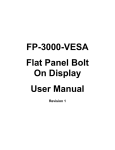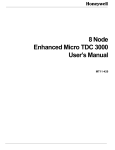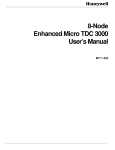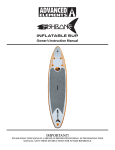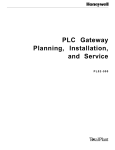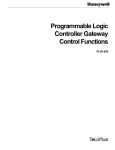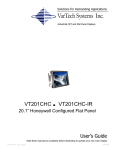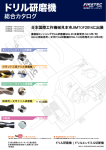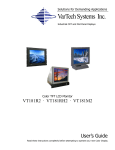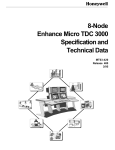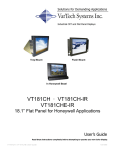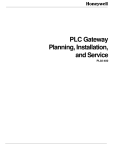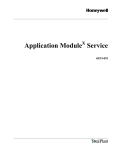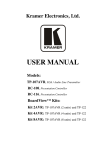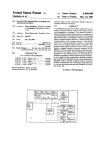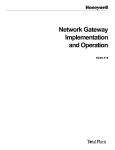Download 8 Node Multinode Module Service
Transcript
L 8 Node Multinode Module Service MT13-420 L Implementation 8 Node Micro TDC 3000 8 Node Multinode Module Service MT13-420 Release 430 CE Compliant 7/95 Copyright, Trademarks, and Notices Printed in U.S.A. — © Copyright 1995 by Honeywell Inc. Revision 02 - July 31, 1995 While this information is presented in good faith and believed to be accurate, Honeywell disclaims the implied warranties of merchantability and fitness for a particular purpose and makes no express warranties except as may be stated in its written agreement with and for its customer. In no event is Honeywell liable to anyone for any indirect, special or consequential damages. The information and specifications in this document are subject to change without notice. About This Publication This publication provides instructions for use by the system service personnel, to service the Multinode Module. It will help you determine how to perform service required on the module and to identify spare parts. It also provides disassembly/assembly instructions useful when replacing the required part. This publication is to be used in conjunction with the remainder of the TDC 3000X bookset. This publication supports TDC 3000X software release 430 and CE Compliant hardware. Any equipment designated as “CE Compliant” complies with the European Union EMC and Health and Safety Directives. All equipment shipping into European Union countries after January 1, 1996 requires this type of compliance—denoted by the “CE Mark.” Change bars are used to indicate paragraphs, tables, or illustrations containing changes that have been made to this manual effective with Release 430 and CE Compliancy. Pages revised only to correct minor typographical errors contain no change bars. Standard Symbols The following defines standard symbols used in this publication Scope ATTENTION Notes inform the reader about information that is required, but not immediately evident CAUTION Cautions tell the user that damage may occur to equipment if proper care is not exercised WARNING Warnings tell the reader that potential personal harm or serious economic loss may happen if instructions are not followed OR 53893 53894 Ground connection to building safety ground Ground stake for building safety ground DANGER SHOCK HAZARD 53895 Electrical Shock Hazard—can be lethal DANGER HIGH VOLTAGE 53896 Electrical Shock Hazard—can be lethal 53897 Rotating Fan—can cause personal injury Table of Contents 1 INTRODUCTION 1.1 1.2 2 MODULE DESCRIPTION 2.1 2.2 2.2.1 2.2.2 2.2.3 2.2.4 2.3 2.4 2.5 3 Overview Related Publications General Description Module and Node Configurations Multinode Module Node Configurations Multinode Module Node Configurations (CE Compliant) Multinode Module Board Types Replacement Board Application Notes Front Panel Rear Panel Field Adjustment TEST/TROUBLESHOOTING 3.1 Tests 3.2 Test Procedures 3.3 Troubleshooting 3.3.1 Power Supply/Fan 3.3.2 PWB Troubleshooting 3.3.2.1 Controller Boards 3.3.2.2 Processor Board K2LCN 3.3.2.3 EPDG Board 4 DISASSEMBLY/ASSEMBLY 4.1 4.2 5 SPARE PARTS 5.1 6 Disassembly Assembly Introduction STARTUP 6.1 6.2 Visual Checks Initialize Module APPENDIX A—ALPHANUMERIC DISPLAYS A.1 Recommended Actions for Specific Code Occurrences INDEX Multinode Module Service i 7/95 Multinode Module Service ii 7/95 1 INTRODUCTION Section 1 1.1 OVERVIEW This manual provides detailed instructions for maintenance, test, troubleshooting, and repair of the Multinode Module shown in Figure 1-1 (with front cover installed) and Figure 1-2. The Multinode Module will not have the front cover installed when mounting in Micro TDC 3000 or LCN cabinets. The troubleshooting, disassembly, and assembly procedures are effective down to the optimum replaceable-unit (ORU) level. An ORU parts list is included and is keyed to a module-exploded view that is also used with the disassembly and assembly procedures. 53679 Figure 1-1 — Multinode Module Multinode Module Service 1-1 7/95 1.1 This manual also contains information about the EC compatible Ten-Slot Module. It accommodates both the older and newer EC I/O board designs. The EC card file remains the same in all other details except each I/O board has a faceplate which provides grounding of the board and cable shield to the card file. The fan intake and exhaust openings on the sides of the module are covered with a honeycomb wire mesh for EC Compliant protection. The EC I/O card file is shown in Figure 1-2. SPC-3 I/O EPDGC I/O TP-485-3 I/O 53898 Figure 1-2 — Multinode Module for EC 1.2 RELATED PUBLICATIONS The following related publications should be referred to as required and available: Title Binder Maintenance Test Operations System Maintenance Guide Test System Executive Hardware Verification Test System Core Module Test System LCN Service/Local Control Network - 1 LCN Service/Local Control Network - 1 LCN Service/Local Control Network - 3 LCN Service/Local Control Network - 3 LCN Service/Local Control Network - 3 8 Node Micro TDC 3000 User's Manual Implementation/8 Node Micro TDC 3000 Multinode Module Service 1-2 7/95 2 MODULE DESCRIPTION Section 2 2.1 GENERAL DESCRIPTION The Multinode Module is designed to mount either horizontally in a standard NEMA rack or vertically in a cabinet (or tower) designed to stand vertically on the floor. Cooling is provided by four fans in one side of the module enclosure. An integral power supply is located at the bottom (or side) of the module. Each Multinode Module supports up to four functional nodes in the TDC 3000 System. Each node occupies a specific address on the Local Control Network (LCN). Figure 2-1 illustrates a typical Micro TDC 3000 System using two Multinode Modules in vertical cabinets. (Example) DEC VAX LEFT TOWER Optional Universal Station Optional Programmable Logic Controller Gateway RIGHT TOWER History Module Application Module Universal Station LCN 620 LCS (Example) Optional Redundant Network Interface Module UNIVERSAL CONTROL NETWORK Optional Computer Gateway Network Interface Module Advanced Process Manager Advanced Process Manager Process Manager Logic Manager 53296 Figure 2-1 — Typical Micro TDC 3000 Multinode Module Application Multinode Module Service 2-1 7/95 2.2 2.2 MODULE AND NODE CONFIGURATIONS Circuit board slots are numbered from 1 to 10 starting at the bottom (nearest the power supply). When the module is oriented vertically, the slots are numbered from right to left. Nodes within a single Multinode Module are in a 3/3/2/2 arrangement, with slots 1 through 3 containing the first node, 4 through 6 containing the second node, slots 7 and 8 containing the third node, and slots 9 and 10 containing the fourth node. The functional control boards are installed in the front card file of the module so that status indicators on the boards may be viewed through the transparent cover. If an Input/Output (I/O) adapter board (or paddleboard) is directly associated with a functional control board, it is installed in the slot behind it in a card file at the rear of the module. Paddleboards which do not perform an I/O function may also be installed in the rear card file in an unused slot. Multinode Module Service 2-2 7/95 2.2.1 2.2.1 Multinode Module Node Configurations Because of the limited board space, the boards used to construct various nodes must contain only certain boards and be configured as shown in Table 2-1. CAUTION Power must be removed from the module whenever you are removing or installing any board, including an I/O paddleboard. Be sure that an I/O paddleboard is installed in the correct slot; some boards have only one slot that they can be installed in without causing damage. I/O paddleboards plugged into the wrong slot can cause traces on the backplane to burn open. In the following table, slot numbers are identified by a-b-c. Remember, in the Multinode Module 3/3/2/2 arrangement, slots are grouped by node, therefore, a given node may occupy slots 1-2-3, 4-5-6, 7-8, or 9-10 to match slots a-b-c, or only a-b. Table 2-1 — Node Configurations for Multinode Modules Application Module (AM) Slot Front Universal Station (US) Rear Slot b a K2LCN-4/6/8 (4) c EPDG b Empty (3) a K2LCN-3/4 (5) Network Interface Module (NIM) Slot Front Front EPDG(P) I/O (1, 2) History Module (HM) Rear Slot Front b EPNI NIM MODEM b SPC a K2LCN-2 (1, 2) a K2LCN-2 Notes: Rear Rear SPC I/O (1) A TP485 I/O card is located in Slot 1 and 9 of the modules in the Micro TDC 3000. (2) The TP485 in Slot 9 provides the interface to the twisted pair, short distance (≤10 meters) TPLCN. (3) The EPDG board set should be slots 3 and 6 with slots 2 and 5 empty. (4) Standard AM is 4 Mw; optional is 6 Mw and 8 Mw. EC Compliant has 4 Mw and 8 Mw only. (5) Standard US is 4 Mw; optional is 3 Mw. EC Compliant has 4 Mw and 6 Mw only. (Continued) Multinode Module Service 2-3 7/95 2.2.1 CAUTION Power must be removed from the module whenever you are removing or installing any board, including an I/O paddleboard. Be sure that an I/O paddleboard is installed in the correct slot; some boards have only one slot that they can be installed in without causing damage. I/O paddleboards plugged into the wrong slot can cause traces on the backplane to burn open. Note that a given node may occupy slots 1-2-3, 4-5-6, 7-8, or 9-10 to match slots a-b-c, or only a-b. Table 2-1 — Node Configurations for Multinode Modules (Continued) Computer Gateway (CG) Slot Front PLC Gateway (PLCG) Rear Slot c CLI a K2LCN-4 CLI I/O b PLCI a K2LCN-2 Redundant NIM Front PLCI I/O Network Gateway (NG) Rear Slot Front Rear NGIO b EPNI NIM MODEM b NGI a K2LCN-3 (1, 2) a K2LCN-2 Notes: Rear c b Slot Front (1) A TP485 I/O card is located in Slot 1 and 9 of the modules in the Micro TDC 3000. (2) The TP485 in Slot 9 provides the interface to the twisted pair, short distance (≤10 meters) TPLCN. Multinode Module Service 2-4 7/95 2.2.2 2.2.2 Multinode Module Node Configurations (CE Compliant) Because of the limited board space, the boards used to construct various nodes must contain only certain boards and be configured as shown in Table 2-1. CAUTION Power must be removed from the module whenever you are removing or installing any board, including an I/O paddleboard. Be sure that an I/O paddleboard is installed in the correct slot; some boards have only one slot that they can be installed in without causing damage. I/O paddleboards plugged into the wrong slot can cause traces on the backplane to burn open. In the following table, slot numbers are identified by a-b-c. Remember, in the Multinode Module 3/3/2/2 arrangement, slots are grouped by node, therefore, a given node may occupy slots 1-2-3, 4-5-6, 7-8, or 9-10 to match slots a-b-c, or only a-b. Table 2-2 — Node Configurations for Multinode Modules (CE Compliant) Application Module (AM) Slot Front Universal Station (US) Rear Slot b a K2LCN-4/8 (4) c EPDG2 b Empty (3) a K2LCN-4/6 (5) Network Interface Module (NIM) Slot Front Front EPDGC I/O (1, 2) History Module (HM) Rear Slot Front b EPNI NIM MODEM b SPC a K2LCN-2 (1, 2) a K2LCN-2 Notes: Rear Rear SPC3 I/O (1) A TP485 I/O card is located in Slot 1 and 9 of the modules in the Micro TDC 3000. (2) The TP485 in Slot 9 provides the interface to the twisted pair, short distance (≤10 meters) TPLCN. (3) The EPDG2 board set should be slots 3 and 6 with slots 2 and 5 empty. (4) Standard AM is 4 Mw; optional is 8 Mw. EC Compliant has 4 Mw and 8 Mw only. (5) Standard US is 4 Mw; optional is 3 Mw. EC Compliant has 4 Mw and 6 Mw only. (Continued) Multinode Module Service 2-5 7/95 2.2.2 CAUTION Power must be removed from the module whenever you are removing or installing any board, including an I/O paddleboard. Be sure that an I/O paddleboard is installed in the correct slot; some boards have only one slot that they can be installed in without causing damage. I/O paddleboards plugged into the wrong slot can cause traces on the backplane to burn open. Note that a given node may occupy slots 1-2-3, 4-5-6, 7-8, or 9-10 to match slots a-b-c, or only a-b. Table 2-2 — Node Configurations for Multinode Modules (CE Compliant) (Continued) Computer Gateway (CG) Slot Front PLC Gateway (PLCG) Rear Slot c CLI a K2LCN-2 CLI I/O b PLCI a K2LCN-2 Redundant NIM Front PLCI I/O Network Gateway (NG) Rear Slot Front b EPNI NIM MODEM b NGI a K2LCN-4 (1, 2) a K2LCN-4 Notes: Rear c b Slot Front Rear NGFOM (1) A TP485 I/O card is located in Slot 1 and 9 of the modules in the Micro TDC 3000. (2) The TP485 in Slot 9 provides the interface to the twisted pair, short distance (≤10 meters) TPLCN. The TP485 in Slot 1 provides the interface to the module temperature sensors. Multinode Module Service 2-6 7/95 2.2.3 2.2.3 Multinode Module Board Types The board types listed in Table 2-3 are the current production board types suitable for use in the Multinode Module. Table 2-3 — Multinode Module Board Types Board Type Description CLI Communications Line Interface Board (PN 80360206-001) CNI I/O Communications Network Interface (PN 51304537-100) CNI I/O Communications Network Interface I/O Brd (EC) (PN 51304537-200) EPDG Enhanced Peripheral Display Generator (PN 51401286-100) EPDG2 Enhanced Peripheral Display Generator (EC) (PN 51402089-100) K2LCN-2 High Performance/Density Processor Board (PN 51401551-200) K2LCN-3 High Performance/Density Processor Board (PN 51401551-300) K2LCN-4 High Performance/Density Processor Board (PN 51401551-400) K2LCN-6 High Performance/Density Processor Board (PN 51401551-600) TP485 TPLCN/Temperature-Sensor Interface Card (PN 51304776-100) TP485-3 Temp.-Sensor I/O Face Plate w/connector (EC) (PN 51304776-300) TP485-4 Temp.-Sensor I/O Face Plate w/o connector (EC) (PN 51304776-400) NIM MODEM Network Interface Module MODEM Card (PN 51304511-100) PLCI Programmable Logic Controller Interface Board (PN 51400997-100) EPLCI Enhanced Prog. Logic Controller Interface I/O (PN 51304812-100) EPNI Enhanced Process Network Interface Board (PN 51401583-100) SPC Smart Peripheral Controller Board (PN 51401052-100) NGI Network Gateway Interface Board (PN 51401583-200) EPDGP I/O Enhanced Peripheral Display Generator Interface Card (PN 51401286-100) EPDGC I/O Enhanced Peripheral Dis. Gen. Int. Card (EC) (PN 51402477-100) SPC I/O Smart Peripheral Controller Interface Card (PN 51304156-100) SPC3 Smart Peripheral Controller Interface Card (EC) (PN 51305088-100) Multinode Module Service 2-7 7/95 2.2.3 Table 2-3 — Multinode Module Board Types (Continued) Board Type Description CLI I/O Communications Line Interface I/O Card (RS-232C) (PN 80360209-001) CLI/B Comm. Line Interface I/O Card (RS-232C) (EC) (PN 51305090-100) CLI I/O Communications Line Interface I/O Card (RS-449) (PN 80360230-001) CLI/A Comm. Line Interface I/O Card (RS-449) (EC) (PN 51305091-100) PLCI I/O Programmable Logic Controller Interface I/O Card (PN 51195096-100) PLCI I/O Prog. Logic Controllers Interface I/O Card (EC) (PN 51195096-200) NGIO Network Gateway Interface I/O Card (PN 51304472-100) CLCN I/O Local Control Network I/O Card (EC) (PN 51305072-100) Refer to subsection 2.2.3 Replacement Board Application Notes, for information about compatible replacements. 2.2.4 Replacement Board Application Notes Table 2-4 lists boards which are dependent upon a minimum software release. Table 2-4 — Replacement Board Applications BOARD TYPE MINIMUM DESCRIPTION SOFTWARE RELEASE * K2LCN 68020 processor and memory board used in all nodes 320 EPDG With the EPDGP I/O board, operates the 20" noninterlaced CRT monitor. The EPDGP I/O also has a Cartridge Disk Interface. 320 TP485 Paddleboard that interfaces short-distance LCN used in the Micro TDC 3000, and interfaces the cabinet temperature sensors (sensors on non-CE Compliant equipment only). 320 TP485-3 I/O I/O board interfaces the current loop interface between the modules located in a Micro TDC 3000 tower. XXX TP485-4 I/O I/O board interfaces the current loop interface between the modules located in a Micro TDC 3000 tower. XXX *All boards are upwards compatible. Multinode Module Service 2-8 7/95 2.3 2.3 FRONT PANEL Controls on the front panel of the power supply consist of a POWER switch, a RESET button, a FAN CONTROL, and a LO-NOM-HI margin jumper. The function and operation of the power and reset controls are discussed elsewhere in this manual. The margin jumper is a power supply test/maintenance diagnostic aide and should be left in the NOM (center) jumper position at all times. The EC power supply contains a fan control switch/jumper and is set for either a thermally-controlled or fixed-fan power (see Figure 3-2). One setting varies the fan voltage with temperature and load. The other setting provides a continuous 27 volts. The front panel contains indicators that provide status of the unit’s performance and aid in fault isolation. The LED indicators on the bottom left of the front panel (the power supply) give an indication of the power-supply status. Another indicator on the fan assembly lights if the fan assembly fails. LEDs on each of the boards are used in conjunction with an alphanumeric display on the processor board to isolate malfunctions on the boards. Further information on the use of the module indicators is located in Section 3 of this manual. 2.4 REAR PANEL The rear panel contains the I/O boards (paddleboards), chassis power-cable, a 100-pin backplane breakout board (if provided), and a grounding lug. As shown in Table 2-1 the I/O boards are installed in the chassis in the slot corresponding in number to the applicable board installed in the front of the module. All communication with the Micro TDC 3000 is through the I/O boards. There are two methods of communicating between nodes on the system. The conventional LCNI I/O paddleboards form the Local Control Network with coaxial cables that run to all of the LCN nodes in a network. In the network, all LCN I/O boards are connected by T connectors and cable (or to a terminating load on the last T in a series). Because of loading characteristics, the minimum LCN cable length is 2 meters (6 feet), so there may appear to be some cable “waste” when nearby LCN boards are interconnected. In all LCN cabling, the I/O board connectors are marked A and B; make sure that the A cable connects to the A connector and that the B cable is connected to the B connector. A special short distance LCN network has been designed which uses twisted pair and multinode module backplane wiring instead of coaxial cable and T connectors. The I/O paddleboards used for this network are the TP485 boards. This twisted pair LCN cabling follows the RS 485 interface standard. One of the K2LCN processor boards and TP485 I/O cards in slot 9 of each tower supplies clock to other nodes on the short distance network. The twisted pair cables which tie this short distance LCN together are keyed so that cables A and B cannot be misconnected and terminating loads are built-in. Ribbon cables are used to connect to such items as the Winchester Drive, Cartridge Drive, and other peripherals. Other connectors, for example RS 232C or RS 449 on the Computer Gateway, are also used. Multinode Module Service 2-9 7/95 2.5 2.5 FIELD ADJUSTMENT There are no field adjustments for the Multinode Module. Each K2LCN board, however, has a node address jumper-pack that must be characterized for the particular node address it occupies on the TPLCN. Refer to subsection 8.1 of the LCN System Installation manual for system pinning. A replacement power supply must be pinned for internal (INT) clock only (see Figure 2-2). (INT) With Link Clock (EXT) No Link Clock E20 E23 E21 52389 Figure 2-2 — Power Supply Showing Location of Clock Jumper Multinode Module Service 2-10 7/95 3 TEST/TROUBLESHOOTING Section 3 3.1 TESTS Testing of the Multinode Module is accomplished through both hardware/firmware tests and software. Hardware/firmware tests are built into the module to provide two means of functionally checking the unit, whether or not it is connected to the LCN. The first test is initiated when power is applied. Pressing the RESET button also initiates the hardware/ firmware test. Software tests can be accomplished when the module is connected to the system. As an example, loading each node's personality initiates a software Quality Logic Test (QLT). There may be up to four nodes physically contained in a Multinode Module. Each node has a processor which can be loaded and tested independently and each node has a different LCN address. The RESET button simultaneously initiates self-tests on all nodes in the module. Figure 3-1 is a flow diagram showing the relationship of the hardware and software tests. 3.2 TEST PROCEDURES NOTE Each Node in a Multinode Module must have a processor board installed before it can be tested. Multiple functions, such as processor, LCN interface, and memory, are physically located on the K2LCN board. Initiate power-up tests by setting the power switch to on. The red LEDs on the boards in eacsh node light for a few seconds (less than 30), then turn off and the green LEDs turn on as each of the boards passes its processor dialog tests. When the tests have been completed, each node's alphanumeric display indicates its node address. Check the power supply ERROR and POWER OK LEDs at the bottom of the unit and the FAN ALARM LED on the right side of the unit to ensure that no red LEDs are on and the green POWER OK LED is lighted. Press the RESET button. The red LEDs momentarily go on as above, then go out when the green LEDs come on. Recheck the power supply, board, and fan LEDs as above. Note that each alphanumeric display indicates its node address. If any of the above conditions cannot be met, refer to subsection 3.3 Troubleshooting. Multinode Module Service 3-1 7/95 3.2 POWER ON/RESET INITIATES HDW/FMW TESTS PASS TEST LIGHT RED LED; LOAD ALPHNUM DISPLAY WITH ERROR CODE NO YES LIGHT GRN LED; RECORD STATUS IN MCT OPERATOR CHK LEDS/ALPHNUM DISPLAY LOAD ALPHNUM DISPLAY WITH NODE NUMBER NODE GOES TO FAILED STATE; XMIT NOTICE OF CRITICAL MALFUNCTIONS XMIT "ALIVE" MSG TO OPERATOR CONSOLE LOAD AND RUN QLT * LIGHT RED LED; LOAD ALPHNUM DISPLAY WITH ERROR CODE YES FATAL ERROR RECORD STATUS IN MCT NO LIGHT GRN LED; LOAD ALPHNUM DISPLAY WITH NODE NUMBER Glossary: MCT — Module Configuration Table ALPHNUM — Alphanumeric HDW/FMW — Hardware/Firmware QLT — Quality Logic Test MSG — Message XMIT — Transmit CHK — Check GRN — Green RECORD STATUS IN MCT XMIT "QUALIFIED" MSG ON LCN LOAD NODE PERSONALITY * Operator Load Request required (Except for HM) CHECK MCT FOR NONFATAL QLT ERRORS ERRORS PRESENT YES ISSUE MAINTENANCE RECOMMENDATIONS NO CONTINUE NORMAL FUNCTIONS Figure 3-1 — Testing Flow Diagram Multinode Module Service 2898 3-2 7/95 3.3 3.3 TROUBLESHOOTING The troubleshooting procedures are grouped by affected ORU and are keyed to the LED indicators and the alphanumeric display. First, a malfunction symptom is listed, then instructions are given to check or replace parts in order of the most likely causes. In the following procedures the indicated LEDs are red unless otherwise stated. Refer to Section 4 for disassembly and assembly instructions. Always turn power off before removing or replacing a part on the module, as this protects equipment from voltage transients and ensures proper initialization. If the fault cannot be corrected by performing these procedures, refer to Appendix A for further information on the alphanumeric display. If the fault still cannot be isolated, contact the Honeywell Technical Assistance Center (TAC). CAUTION All assemblies used in this module are likely to contain electrostatically sensitive devices. Use personnel grounding strap and grounded work surfaces/equipment. Store and transport parts only in electrostatically safe containers. 3.3.1 Power Supply/Fan Refer to Figure 3-2. No LEDs light at all. • Check power cord and power off-on switch. • Replace power supply. Red ERROR power-status LED on or green POWER OK LED off. • Replace power supply. • If red LED is still on, check for shorted backpanel bus. FAN ALARM LED on. WARNING Rotating parts. Keep fingers and other objects clear of fans. • If necessary, loosen mounting hardware and slide module out of rack. Check fans. If all fans are stopped, check the wiring to them. • If one or more fans are stopped, replace fan assembly. • Replace power supply. • Check for missing or defective thermal sensors. Multinode Module Service 3-3 7/95 3.3.1 10 9 8 7 Fan Assembly 6 5 4 3 2 Fan Alarm LED 1 Error Reset Switch Power OK Fan Control ON Lo-Nom-Hi Jumper Power Supply 54004 Figure 3-2 — EC Power Supply and Fan Indicators Multinode Module Service 3-4 7/95 3.3.2 3.3.2 PWB Troubleshooting The K2LCN processor boards used in the Multinode Module have indicators on the front of the board to indicate error conditions. These processor boards have a red LED bar display with no labels as shown in Figure 3-3. In the sections to follow, use these indicators in conjunction with indicators on the inputoutput and controller boards to find the faulty PWB. Data DTAK BGAK Data RST/PWR Self-Test Compare Time Time Parity Fail Error Error Out Out Error Self-Test Pass (Green) Bus Error EDAC Multi-Bit Error EDAC Single-Bit Error LCN Transaction Error Node Address/Error Display TX (Yellow) Red LEDs 40022 Figure 3-3 — K2LCN Indicators NOTE Remove module front panel to view the board LEDs and to check the alphanumeric display (the Node Address/Error Display). The Node Address/Error Display provides an alphanumeric code to aid in finding ORU faults. When directed to this display, consult Appendix A to interpret its meaning. Multinode Module Service 3-5 7/95 3.3.2 3.3.2.1 Controller Boards (CLI EPNI NGI SPC) SELF TST/ERR light does not go out. • Replace controller board. • Ensure that I/O paddleboard is properly installed. • Replace I/O paddleboard. SELF TST/ERR light goes out, but PASS MOD TEST (green) light does not light on controller board. • Replace controller board. • Ensure that I/O paddleboard is properly installed. • Replace I/O paddleboard. • Replace K2LCN. SELF TST/ERR light goes out, but PASS MOD TEST (green) light does not light on all controllers. • Replace K2LCN. • Remove controller board, then apply power. Repeat for each controller board until fault is cleared. Retry extracted boards. BUS TRAN ERR light is lighted on controller, and DTAK TIME OUT is lighted on the K2LCN. • Replace controller board. • Replace K2LCN. BUS TRAN ERR light is lighted on a controller, and BGAK TIME OUT is lighted on the K2LCN. • Remove controller board, then apply power. If fault is cleared, replace controller board. • Replace K2LCN. Multinode Module Service 3-6 7/95 3.3.2 3.3.2.2 Processor Board K2LCN DATA PAR ERR and BUS ERR are lit. • Check alphanumeric display. First two digits denote the slot number (in the node) of the failed board. (Third digit/letter is the failed test number.) • Replace indicated board. • Replace processor board. 3.3.2.3 EPDG Board SELF TST/ERR light does not go out on EPDG. • Replace EPDG. • Replace processor board. SELF TST/ERR light goes out on EPDG, but PASS MOD TEST (green) light does not light on EPDG. • Replace EPDG. • Replace processor board. BUS TRAN ERR is lighted on EPDG and DTAK TIME OUT is lighted on K2LCN, but the BUS ERR light is not on. • Replace EPDG. • Replace processor board. BUS TRAN ERR is lighted on EPDG and DTAK TIME OUT and BUS ERR is lighted on K2LCN. • Replace EPDG. • Replace processor board. Multinode Module Service 3-7 7/95 Multinode Module Service 3-8 7/95 4 DISASSEMBLY/ASSEMBLY Section 4 4.1 DISASSEMBLY The Module should be disassembled only to the extent necessary to service or replace defective parts. The following procedures require the use of a blade-tip or Phillips (if EC hardware) screwdriver, personnel grounding strap, and antistatic fixtures and equipment. Item numbers called out in the procedures refer to ballooned numbers in the exploded Multinode Module diagram, Figure 4-1, and are keyed to the item numbers in Spare Parts, Section 5. 1. Remove front panel (if supplied) from chassis (1) by turning two quarter-turn fasteners on the right side of the panel and swinging panel out. CAUTION All assemblies used in this Module are likely to contain electrostatically sensitive devices. Use a personnel grounding strap and grounded work surfaces and equipment. Store and transport parts only in electrostatically safe containers. 2. Remove boards (2) by pulling out on retainers and sliding boards out of chassis. 3. Remove fan assembly (5) by unscrewing bail-headed screws 1/4 turn, counter clockwise, and sliding out of chassis. 4. Remove power supply (4) by pulling retainers and sliding out of chassis. 5. Remove I/O boards (6) from rear chassis. If removing EC I/O boards, a Phillips head screwdriver is required. Multinode Module Service 4-1 7/95 2 4 1 3 5 6 4.1 Figure 4-1 — Multinode Module Exploded View Multinode Module Service 4-2 2888 7/95 4.2 NOTE Before inserting a replacement board: 1. Make certain that the replacement board is at a revision level equal to or later than the board being replaced. 2. Make certain that the pinning of the node address on a K2LCN board matches that on the board being replaced. 4.2 ASSEMBLY 1. Assemble I/O boards (6) to rear chassis, taking care not to damage connectors, and secure board retainers. Care should be taken to ensure that the I/O boards match the primary boards. If present, reconnect cables to replaced boards. 2. Insert power supply (4) into chassis and secure retainers. 3. Insert fan assembly (5) into chassis and secure bail-headed screws. 4. Insert boards (2) into chassis and secure retainers. If present, reconnect ribbon cables to replaced boards. 5. Assemble front panel (1) to chassis and secure quarter-turn fasteners. Multinode Module Service 4-3 7/95 Multinode Module Service 4-4 7/95 5 SPARE PARTS Section 5 5.1 INTRODUCTION Table 5-1 lists spare parts for the Multinode Module. Those parts at the ORU level are marked with an asterisk (*). The listing is arranged in item-number order with the items keyed to the call-out balloons in Figure 4-1. Also listed are those boards suitable for use in the Multinode Module configurations. In some cases, more than one part is assigned to an item number (for instance any one of several board assemblies can occupy a slot in the module). In this situation, the list is in part-number order. Table 5-1 — Parts List ITEM PART NUMBER 1 51400919-100 10-Slot Module Cover Assembly (may not be required) 2* 51400955-100 PNI Board Assembly, Process Network Interface 2* 51400955-100 EPNI/NGI 2* 51400997-100 PLCI Programmable Logic Controller Interface 2* 51401052-100 SPC Board Assy., Smart Peripheral Interface Controller 2* 51401286-100 EPDG Board Assy., Enhanced Peripheral Display Generator 2* 51401286-100 EPDG2 Board Assy. 2* 51401551-200 K2LCN Board Assembly, Processor (LCN Intf & 2 M Memory) 2* 51401551-300 K2LCN Board Assembly, Processor (LCN Intf & 3 M Memory) 2* 51401551-301 K2LCN Board Assembly 2* 51401551-400 K2LCN Board Assembly, Processor (LCN Intf & 4 M Memory) 2* 51401551-600 K2LCN Board Assembly, Processor (LCN Intf & 6 M Memory) 2* 51401551-601 K2LCN Board Assembly 2* 51401583-100 EPNI Board Assembly, Enhanced Process Network Interface DESCRIPTION (Continued) Multinode Module Service 5-1 7/95 5.1 Table 5-1 — Parts List (Continued) PART ITEM NUMBER DESCRIPTION 2* 51401583-200 NGI Board Assembly, Network Gateway Interface 2* 80360206-001 CLI Board Assembly, Computer/LCN Interface 3* 51401782-100 3/3/2/2 Split Node Cardfile (w/out power supply, fan assembly) 3* 51402491-100 3/3/2/2 Split Node Cardfile, (EC) 4* 51195066-200 Power Supply 4* 51196654-100 10-Slot Pwr Supply w/Temp Sense Sw. (EC) 5* 51400647-100 10-Slot Fan Assembly (large) 6* 51304511-100 NIM MODEM Adapter Board Assembly 6* 51304511-200 NIM MODEM Adapter Board Assembly (EC) 6* 51304156-100 SPC I/O Adapter Board Assembly 6* 51305088-100 SPC3 I/O Adapter Board Assembly, (EC) 6* 51304584-100 EPDGC I/O Adapter Board Assembly, (EC) 6* 51304584-100 EPDGP I/O Adapter Board Assembly 6* 51304776-100 TP485 Adapter Board Assembly 6* 51304472-100 NGIO Adapter Board Assembly 6* 80360209-001 CLI I/O Adapter Board Assembly (RS-232C) 6* 51305090-100 CLI/B Card (RS-232C) (EC) 6* 80360230-001 CLI I/O Adapter Board Assembly (RS-449) 6* 51305091-100 CLI/A Card (RS-449) (EC) 6* 51304537-100 CNI Communications Network Interface 6* 51304537-200 CNI I/O Communications Network Interface I/O Brd, (EC) 6* 51195096-100 PLCI I/O Adapter Board Assembly 6* 51195096-200 PLCI I/O Adapter Board Assembly (EC) (Continued) Multinode Module Service 5-2 7/95 5.1 Table 5-1 — Parts List (Continued) PART ITEM NUMBER * 51304421-100 PLCG Relay Panel Assembly * 51304421-200 PLCG Relay Panel Assembly (EC) 51303508-100 Power Cord, 125 V 51303508-200 Power Cord, 250 V 51308115-100 Power Cord (EMI Filter), 120/240 V (EC) 51191840-X0X Power Cable, Shielded, PVC Jacket, 120/240 V (EC) Multinode Module Service DESCRIPTION 5-3 7/95 Multinode Module Service 5-4 7/95 6 STARTUP Section 6 6.1 VISUAL CHECKS • Check Module power and signal cables to ensure that they are present and tight. • Check ground strap and/or leads on rear of chassis for good connection. • Ensure that all boards and power supply are fully inserted into the connectors and that board retainers are secured. 6.2 INITIALIZE MODULE • Set power switch to on. Check all LEDs in accordance with Test Procedures, subsection 3.2. • Press RESET button. Check LEDs again as above. Multinode Module Service 6-1 7/95 Multinode Module Service 6-2 7/95 A ALPHANUMERIC DISPLAYS Appendix A The alphanumeric display enhances the man-machine interface by displaying hardware/ firmware and software-driven messages. In interpreting the messages, special attention should be paid to the left-most element. As shown in Figure A-1, this element can have four distinct states and the correct reading of the display is critical to understanding the message. First "Window" Interpretation // // (blank) or (1) — normal (physical node address) (-) or (-1) — Error indication "Window" value ranges (0, 1, 2, 3, 4, 5, 6, 7, 8, 9, A, -, C, blank, E, F) (-, -1, blank) Figure A-1 — Three-window Display Interpretation 2470 NOTE The error code interpretations that follow do not apply while the node is executing test software such as HVTS. Multinode Module Service A-1 7/95 A A.1 Recommended Actions for Specific Code Occurrences NOTE The Multinode Module contains a maximum of four nodes with each node occupying slots which are numbered 1-2-3, 4-5-6, 7-8, or 9-10. Each node’s processor (and its alphanumeric display) is always located in slot 1 or 4 or 7 or 9. To simplify the following explanation, slots are identified by a, b, or c which define the 1st, 2nd, or 3rd board in a given node regardless of its physical slot location. Please note, when multiple recommendations are given for a window code-value, they are organized in order from most to least likely. Recommendations marked with * indicate an unimplemented code-value. Any such occurrence should be brought to the attention of Honeywell TAC. Window values marked as - 0 // - 1 n n=(-) // are "don't care" values. replace K2LCN* replace K2LCN; replace boards in slots b through c in turn n=(1 thru 7) replace K2LCN n=(other) - 2 replace K2LCN* n n=(1 thru 7) replace board in slot b; replace K2LCN; replace the module backplane or chassis assembly n=(-) or (C) replace board in slot b; replace K2LCN; replace board in slot c if one exists; replace the module backplane or chassis assembly n=(other) replace K2LCN* Multinode Module Service A-2 7/95 A - 3 n n=(1 thru 7), (-) or (C) replace board in slot b/c; replace K2LCN; replace the module backplane or chassis assembly n=(other) - 4 replace K2LCN* n n=(1 thru 7), (-) or (C) replace K2LCN; replace the module backplane or chassis assembly n=(other) - 5 replace K2LCN* n n=(1 thru 7), (-) or (C) replace K2LCN; replace the module backplane or chassis assembly n=(other) - 6 replace K2LCN* n n=(1 thru 7), (-) or (C) replace K2LCN; replace the module backplane or chassis assembly n=(other) - 7 replace K2LCN* n n=(1 thru 7), (-) or (C) replace K2LCN; replace the module backplane or chassis assembly n=(other) replace K2LCN* Multinode Module Service A-3 7/95 A - 8 n n=(1 thru 7), (-) or (C) replace K2LCN; replace the module backplane or chassis assembly n=(other) - 9 replace K2LCN* n n=(1 thru 7), (-) or (C) replace K2LCN; replace the module backplane or chassis assembly n=(other) - A replace K2LCN* n n=(A) or (C) replace K2LCN n=(other) replace K2LCN* - - // replace K2LCN* - C // replace K2LCN* - n n=(A) if value persists beyond 30 seconds, replace K2LCN n=(other) replace K2LCN* Multinode Module Service A-4 7/95 A - E n n=(0) an unexpected interrupt has occurred, replace K2LCN n=(1) replace K2LCN; replace boards in slots b through c in turn; n=(2) no working DRAM, replace K2LCN n=(3) suspected program error, replace K2LCN n=(5) unverified cause of Level 7 interrupt, - replace K2LCN; replace the power supply n=(other) replace K2LCN* - F // replace K2LCN* -1 0 // n=(1 thru 7), (-) or (C) replace K2LCN board; replace the module backplane or chassis assembly n=(other) -1 1 replace K2LCN* // replace K2LCN* -1 2 // replace K2LCN* -1 3 // replace K2LCN* -1 4 // replace K2LCN* Multinode Module Service A-5 7/95 A -1 5 // replace K2LCN* -1 6 // replace K2LCN* -1 7 n n=(0), (1) check for duplicate node number; check/replace TPLCN cable; replace K2LCN n=(2 thru 5) replace K2LCN board; replace K2LCN in other nodes n=(6) replace Winchester (drive or interface) n=(7 thru 9) reload node, replace K2LCN n=(other) -1 8 replace K2LCN* n n=(0 thru 2) replace EPDG board n=(3) reload node, replace K2LCN n=(4,5,8) check for proper release version of the software; reboot system n=(9) check/replace TPLCN cable; check for proper release version of the software; reboot system n=(A,C,E,F) suspect the load image; check the software release version and reload the node n=(other) replace K2LCN* Multinode Module Service A-6 7/95 A -1 9 n n=(0,3,4,5) reboot system n=(1 or 2) record error messages and call Honeywell TAC n=(6) use SMCC to find defective board n=(7,8) check memory capacity; replace K2LCN; check and reload software n=(9) check and reload software; replace K2LCN n=(other) replace K2LCN* -1 A // replace K2LCN* -1 - // replace K2LCN* -1 C // replace K2LCN* -1 // replace K2LCN* -1 E n n=(2) replace board in slot number a n=(3) replace board in slot number c n=(other) replace K2LCN* Multinode Module Service A-7 7/95 A -1 F n n=(0 thru 8), (E) or (F) replace K2LCN n=(9) or (A) replace K2LCN* n=(-) or (C), or (blank) replace K2LCN board; if error repeats, look for bus problems n=(other) check and/or replace backplane or chassis assembly Multinode Module Service A-8 7/95 Index Topic Section Heading Alphanumeric Displays APPENDIX A Assembly Disassembly DISASSEMBLY/ASSEMBLY EC Compliant Field Adjustment Front Panel General Description Initialize Module INTRODUCTION MODULE DESCRIPTION Module and Node Configurations Multinode Module (EC Compliant Multinode Module Node Configurations Multinode Module Node Configurations (CE Compliant) Multinode Module Board Types Replacement Board Application Notes Overview Rear Panel Related Publications SPARE PARTS Introduction STARTUP Test Procedures TEST/TROUBLESHOOTING Tests Troubleshooting Power Supply/Fan PWB Troubleshooting Memory Boards Processor Boards EPDG Board Visual Checks A.1 A 4.2 4.1 4 1.1 2.5 2.3 2.1 6.2 1 2 2.2 1.1 2.2.1 2.2.2 2.2.3 2.2.4 1.1 2.4 1.2 5 5.1 6 3.2 3 3.1 3.3 3.3.1 3.3.2 3.3.2.2 3.3.2.3 3.3.2.4 6.1 Multinode Module Service Index - 1 7/95 Multinode Module Service Index -2 7/95 READER COMMENTS Honeywell IAC Automation College welcomes your comments and suggestions to improve future editions of this and other publications. You can communicate your thoughts to us by fax, mail, or toll-free telephone call. We would like to acknowledge your comments; please include your complet name and address BY FAX: Use this form; and fax to us at (602) 313-4108 BY TELEPHONE: In the U.S.A. use our toll-free number 1*800-822-7673 (available in the 48 contiguous states except Arizona; in Arizona dial 1-602-313-5558). BY MAIL: Use this form; detach, fold, tape closed, and mail to us. Title of Publication: C8 Node Multinode Module Service Issue Date: 7/95 Publication Number: MT13-420 (R430/EC) Writer: D. Downey COMMENTS: ___________________________________________________________ _______________________________________________________________________ _______________________________________________________________________ _______________________________________________________________________ _______________________________________________________________________ _______________________________________________________________________ _______________________________________________________________________ _______________________________________________________________________ RECOMMENDATIONS:___________________________________________________ _______________________________________________________________________ _______________________________________________________________________ _______________________________________________________________________ _______________________________________________________________________ _______________________________________________________________________ _______________________________________________________________________ _______________________________________________________________________ NAME _______________________________________ DATE ____________________ TITLE _________________________________________________________________ COMPANY _____________________________________________________________ ADDRESS ______________________________________________________________ CITY ________________________ STATE ___________ ZIP ____________________ TELEPHONE _____________________ FAX _________________________________ (If returning by mail, please tape closed; Postal regulations prohibit use of staples.) Communications concerning technical publications should be directed to: Automation College Industrial Automation and Control Honeywell Inc. 2820 West Kelton Lane Phoenix, Arizona 85023-3028 FOLD FOLD From: NO POSTAGE NECESSARY IF MAILED IN THE USA FIRST CLASS PERMIT NO. 4332 Cut Along Line BUSINESS REPLY MAIL PHOENIX, ARIZONA POSTAGE WILL BE PAID BY .... Honeywell Industrial Automation and Control 2820 West Kelton Lane Phoenix, Arizona 85023-3028 Attention: Manager, Quality FOLD Additional Comments: FOLD Industrial Automation and Control Honeywell Inc. 16404 North Black Canyon Highway Phoenix, Arizona 85023-3099 L Helping You Control Your World




















































